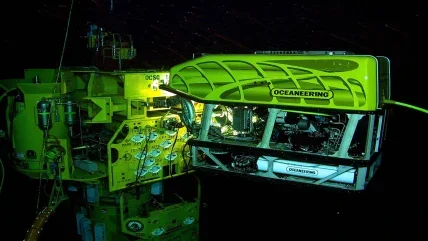
For over a decade remote operated vehicle (ROV) manufacturer Deep Trekker, has been specialising in underwater inspections with their line of portable and affordable battery-operated inspection robots. Based in Ontario, Canada, the company offers three different ROV models to perform a variety of hydropower plant inspections.
Deep Trekker’s DTG3 is an effective tool for quick inspections through low current conditions and confined spaces. This compact machine offers HD photo and video at an approachable price point for operations that are just beginning their work with submersible robotics. Deep Trekker also offers the PIVOT and REVOLUTION ROVswhich provide superior power and stability through currents and their advanced stabilisation systems allow for the integration of a wide variety of sophisticated inspection equipment.
The PIVOT and REVOLUTION are both equipped with six powerful, magnetically coupled thrusters which enable lateral and vertical movements, as well as tilting tool platforms for add-ons like positioning systems, dissolved oxygen sensors, or sonars. Integration with high quality multibeam imaging sonars like the M3000D allow the ROV to see even in zero visibility conditions.
What are the advantages of using ROVs in hydroelectric inspections?
Traditionally, inspections of hydroelectric turbines or water passages would have required a dewatering process for safety and access. Dewatering and scaffolding are extremely expensive and costly in terms of time and resources. Deep Trekker ROVs’ compact yet rugged design allows them to navigate through complex confined spaces without putting divers at risk or stopping operations to dewater. ROVs from Deep Trekker have been used by OPG, Duke Energy, Hydro Quebec, and TVA to safely inspect runners, penstocks, submerged pipes, and transmission lines without the burden of dewatering.
Optimise diver missions
If initial inspection uncovers a potential issue, divers may be required to enter the water. Even against best efforts and precautions, whenever humans enter the water, accidents can happen.
According to a 2016 analysis of fatal accidents in the commercial diving sector [1], over the past 40 years there have been 577 recorded fatalities in commercial diving, occurring at a rate in the US of 181 per 100,000. Averaging over one death per month, this places commercial diving as the most dangerous industry during the time of study.
Differential Water Pressure (Delta P) has become a growing concern for dive teams in the hydropower space after it has been identified as the cause of death for one in four diving fatalities. Drowning, equipment malfunction, and becoming trapped or crushed are other common causes.
Underwater ROVs can quickly and safely provide real-time pre-dive checks to provide critical information relating to dangerous work environments. The vehicle can also be equipped with accessories for simple mechanical work, cleaning, or water analysis to minimise required diver tasks. Alternatively, an ROV can also quickly be deployed alongside a diver to monitor their status as a method of communication with the topside team or provide sonar imaging through turbid conditions.
Reservoir, intake, and trash rack
An ROV equipped with multibeam imaging sonar can be used to identify damage to reservoir walls, assess the size, and with an underwater positioning system you can easily navigate back to the precise coordinates of a crack, and monitor it over time. Additionally, any minor debris found in trash racks or intake gates can feasibly be removed by an ROV utilising a grabber arm.
Invasive species like zebra mussels can colonise on intake structures and accumulate to the point where water flow is severely impeded. ROVs can be used to monitor their growth and effectively clean them off structures without dewatering or damaging expensive coatings.
Simplified inspection reports
ROVs are equipped with high-definition cameras and powerful LED lighting to produce clear imaging. Their live feed can be recorded directly to SD cards or external hard drives for later use. Readings of depth, temperature, coordinates, etc, allow for enhanced monitoring of long-term progression of potential issues, or for inspection contractors to provide reports to clients. Building a standardised asset status report allows for efficient repair forecasting to keep costs and downtimes as low as possible.
GE Renewable Energy
In May of 2021, GE Renewable Energy unveiled a new solution to perform underwater hydropower turbine inspections. Utilizing Deep Trekker’s REVOLUTION ROV, GE’s Hydro Solutions’ underwater robotised turbine inspection solution can inspect hard-to-reach areas of any type of hydropower turbines without dewatering the equipment. Designed, developed and tested with Deep Trekker’s innovation team, this solution is the next step in hydropower turbine condition assessment.
GE has successfully used the REVOLUTION ROV equipped with customised 360-degree camera technology to inspect blades on Kaplan, Francis, and pump turbines and runners. They noted that since adopting an ROV based inspection process, they have reduced associated costs, inspection risks and outage time by 95% without reducing inspection quality.
GENIFAB
One company with extensive experience in the hydro industry is GENIFAB. This engineering firm specializes in the field of heavy mechanical devices, such as locks, mobile bridge mechanics, and ferry loading dock mechanisms, among other systems. In 2007, GENIFAB saw an increase in their calls for inspection work. Up until that time, they were generally employed as design engineers working in tandem with commercial divers to provide inspection services.
The calls for inspection assistance were often after major mechanical failures or a broken gate at one of the hydroelectric dams. Donald Dupont from GENIFAB said: "The cost of divers was prohibitive for performing preliminary inspections or preventative inspections, it was also difficult to coordinate with their schedules”.
As a result, GENIFAB needed to innovate in order to grow. To address the concerns of unscalable diver costs, GENIFAB looked to ROVs as a cost-effective robotic solution.
Choosing the DTG3 by Deep Trekker enabled them to conduct inspections quickly and easily, without any external contracting. Without the dangers associated with manual inspections, certain underwater tasks could now be performed without any downtime for the plant.






